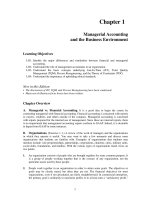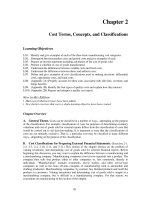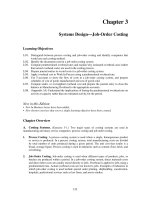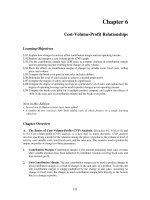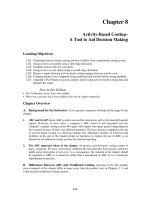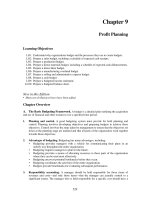Overview managerial accounting chapter 09
Bạn đang xem bản rút gọn của tài liệu. Xem và tải ngay bản đầy đủ của tài liệu tại đây (3.08 MB, 75 trang )
Chapter 9
Profit Planning
Learning Objectives
LO1.
LO2.
LO3.
LO4.
LO5.
LO6.
LO7.
LO8.
LO9.
LO10.
Understand why organizations budget and the processes they use to create budgets.
Prepare a sales budget, including a schedule of expected cash receipts.
Prepare a production budget.
Prepare a direct materials budget, including a schedule of expected cash disbursements.
Prepare a direct labor budget.
Prepare a manufacturing overhead budget.
Prepare a selling and administrative expense budget.
Prepare a cash budget.
Prepare a budgeted income statement.
Prepare a budgeted balance sheet.
New in this Edition
• Many new In Business boxes have been added.
Chapter Overview
A. The Basic Budgeting Framework. A budget is a detailed plan outlining the acquisition
and use of financial and other resources over a specified time period.
1.
Planning and control. A good budgeting system must provide for both planning and
control. Planning involves developing objectives and preparing budgets to achieve those
objectives. Control involves the steps taken by management to ensure that the objectives set
down at the planning stage are attained and that all parts of the organization work together
towards those objectives.
2.
Advantages of budgeting. Budgeting has many advantages, including:
• Budgeting provides managers with a vehicle for communicating their plans in an
orderly way throughout the entire organization.
• Budgeting requires managers to plan for the future.
• Budgeting provides a means of allocating resources to those parts of the organization
where they can be used most effectively.
• Budgeting uncovers potential bottlenecks before they occur.
• Budgeting coordinates the activities of the entire organization.
• Budgets provide benchmarks for evaluating subsequent performance.
3.
Responsibility accounting. A manager should be held responsible for those items of
revenues and costs—and only those items—that the manager can actually control to a
significant extent. The manager who is held responsible for a specific cost should have a
529
budget specifying a limit on how much can be spent. This limit may be adjusted, depending
on the activity during the period. This idea will be developed in later chapters.
4.
Choosing a budget period. Budget periods vary in length. Some may be as short as a
month, whereas others may cover many years. The most common budgeting period,
however, is a year.
• Operating budgets ordinarily cover a one-year period. Additionally, many companies
divide their operating budgets into quarterly or monthly periods.
• A continuous or perpetual budget covers a 12-month period but adds a new month on
the end as the current month is completed. This approach stabilizes the planning
horizon at one year.
5.
Self-imposed participative budget. The most successful budget programs usually involve
lower-level managers in preparing their own budgets—although this point is in some
dispute. There are two basic reasons for favoring participative budgets: 1) lower-level
managers are more familiar with the details of their own operations than top managers and
2) managers tend to be more committed to budgets that they have been able to influence.
6.
Human relations. Management must keep clearly in mind that budgeting involves
coordinating and motivating people and the human dimension is of primary importance.
a. Top managers must clearly convey the message in actions as well as in words that
budgeting is important. If top management appears to be ambivalent about the benefits
of budgeting, others in the organization will be reluctant to commit their own time and
energy to the budgeting process.
b. If there is a preoccupation with getting every dollar and cent right or with placing
blame, the budgeting process will be resented and managers will attempt to “game the
system.” Budgets should not be used as a club. They should be a way of ensuring that
everyone understands what is expected. Significant deviations from the budget should
be investigated so that managers understand changing conditions and their implications
for the organization. Managers should not ordinarily be punished for deviations from
the budget.
B. Preparing the Master Budget. (Exercise 9-1 through Exercise 9-7.) The master budget
consists of a number of separate, but interrelated budgets. The interrelationships among these
various budgets are illustrated in Exhibit 9-2 in the text. Schedules 1 through 10 in the text
present a comprehensive example of a master budget.
1.
The Sales Budget (Exercise 9-1; Schedule 1 in the text). The sales budget is a detailed
schedule showing the expected sales for the coming period. It is typically expressed in both
dollars and units of the product. The sales budget is usually accompanied by a schedule of
expected cash receipts. The schedule of expected cash collections should take into account
delays in collecting credit sales.
2.
The Production Budget (Exercise 9-2; Schedule 2 in the text). The budgeted production
for each period can be determined by adding together the budgeted sales and the desired
ending inventory and then subtracting the beginning inventory. The desired ending
inventory in units for each period is usually a predetermined percentage of budgeted unit
sales for the following period. The production budget is typically expressed in terms of
physical units rather than in dollars.
In a merchandising company, a merchandise purchases budget would replace the
production budget. The merchandise purchases budget shows the amount of goods to be
530
purchased from suppliers each period. This can be determined by adding together the
budgeted sales and the desired ending inventory and then subtracting the beginning
inventory. As in a manufacturing company, the desired ending inventory in units is usually
some predetermined percentage of the unit sales for the following period.
3.
The Direct Materials Budget (Exercise 9-3; Schedule 3 in the text). Once production
needs have been determined, a direct materials budget should be prepared. This budget
details the materials that will be required to fulfill the production budget and to ensure
adequate inventory levels. Sufficient amounts of raw material must be acquired to meet
both production needs and to provide for desired ending inventories. Materials purchases
are determined by adding together the materials required for production needs and the
desired ending materials inventories, and then subtracting the beginning inventory. The
desired ending inventory in units is usually a predetermined percentage of the number of
units expected to be used in production the following period. The direct materials budget is
usually accompanied by a schedule of expected cash disbursements for raw materials. This
schedule should take into account any delays that are anticipated in paying for materials.
4.
The Direct Labor Budget (Exercise 9-4; Schedule 4 in the text). Once production needs
are known, the direct labor budget must be prepared so that the company will know
whether sufficient labor time is available to meet those needs. The direct labor budget is
typically expressed in both direct labor-hours and in dollars. Translating the direct-labor
requirements into spending can lead to complications if there is overtime or if there is some
sort of guaranteed employment policy.
5.
The Manufacturing Overhead Budget (Exercise 9-5; Schedule 5 in the text). The
manufacturing overhead budget lists all production costs other than direct materials and
direct labor. Manufacturing overhead costs should be broken down by cost behavior for
budgeting purposes. Typically, the variable portion of manufacturing overhead is assumed
to be proportional to budgeted activity and the fixed portion is assumed to be constant in
total. Under the assumption that depreciation is the only significant non-cash
manufacturing overhead expense, the manufacturing overhead expense can be converted to
a cash flow basis by backing out of the total any depreciation charges.
6.
Ending Finished Goods Inventory Budget (Schedule 6 in the text). This budget details
the amount and value of ending inventory on the budgeted balance sheet. The unit product
cost from this budget is also used to compute the cost of goods sold for the budgeted
income statement. The details of the computations will depend on whether variable or
absorption costing is used. Managers often want budgets on an absorption costing basis
since that is the basis that will ordinarily be used to report results to outsiders. Data for the
computations in this schedule are found in the direct materials, direct labor, and
manufacturing overhead budgets.
7.
The Selling and Administrative Expense Budget (Exercise 9-6; Schedule 7 in the text).
The selling and administrative budget lists the anticipated non-manufacturing expenses for
the budget period. In practice this budget is usually made up of many smaller individual
budgets negotiated with various managers having sales and administrative responsibilities.
Setting appropriate budget limits for selling and administrative functions is one of the most
difficult problems in management accounting and is just beginning to be understood.
8.
The Cash Budget (Exercise 9-7; Schedule 8 in the text). The cash budget should be broken
down into time periods that are as short as feasible so as to alert management to problems
531
that may occur due to fluctuations in cash flows. As anyone with a checking account
knows, it is quite possible to have a positive overall cash flow during a period and yet be
overdrawn at some point during the period. The cash budget is composed of four major
sections:
a. The receipts section.
b. The disbursements section.
c. Cash receipts, plus the beginning cash balance, less cash disbursements results in cash
excess or deficiency. In the case of a deficiency, management must arrange to borrow
additional funds. In the case of excess cash, management can use the excess funds to
repay previous borrowing or to make new investments.
d. The financing section of the cash budget details the borrowing and repayments
projected to take place during the budget period, including any interest payments.
9.
Budgeted Financial Statements (Schedule 9 in the text). The last components of the
master budget consist of the budgeted income statement and the budgeted statement of
financial position. The balance sheet is perhaps the most difficult of the statements to
construct in the examples we use. It requires pulling together data from a variety of
schedules and sources.
532
Assignment Materials
Assignment
Exercise 9-1
Exercise 9-2
Exercise 9-3
Exercise 9-4
Exercise 9-5
Exercise 9-6
Exercise 9-7
Problem 9-8
Problem 9-9
Problem 9-10
Problem 9-11
Problem 9-12
Problem 9-13
Problem 9-14
Problem 9-15
Problem 9-16
Problem 9-17
Problem 9-18
Problem 9-19
Problem 9-20
Problem 9-21
Problem 9-22
Case 9-23
Case 9-24
Case 9-25
Level of
Topic
Difficulty
Schedule of expected cash collections.......................................
Basic
Production budget......................................................................
Basic
Materials purchases budget........................................................
Basic
Direct labor budget ....................................................................
Basic
Manufacturing overhead budget ................................................
Basic
Selling and administrative budget..............................................
Basic
Cash budget analysis..................................................................
Basic
Evaluating a company’s budget procedures ..............................
Basic
Schedule of cash collections; cash budget.................................
Basic
Behavioral aspects of budgeting; ethics and the manager .........
Basic
Production and purchases budgets.............................................
Basic
Direct materials and direct labor budgets ..................................
Basic
Direct labor and manufacturing overhead budgets ....................
Basic
Schedules of expected cash collections and disbursements.......
Basic
Cash budget; income statement; balance sheet..........................
Basic
Cash budget with supporting schedules..................................... Medium
Integration of the sales, production, and purchases budgets...... Medium
Cash budget with supporting schedules..................................... Medium
Completing a master budget ...................................................... Medium
Completing a master budget ...................................................... Medium
Cash budget for one month........................................................ Difficult
Integrated operating budgets...................................................... Difficult
Evaluating a company’s budget procedures .............................. Difficult
Master budget with supporting schedules.................................. Difficult
Cash budget for a growing company ......................................... Difficult
Suggested
Time
20 min.
10 min.
15 min.
20 min.
15 min.
15 min.
20 min.
30 min.
45 min.
45 min.
45 min.
30 min.
30 min.
30 min.
60 min.
60 min.
60 min.
60 min.
120 min.
120 min.
60 min.
90 min.
45 min.
120 min.
75 min.
Essential Problems: Problem 9-11, Problem 9-13, Problem 9-14, Problem 9-15, Problem 9-19 or
Problem 9-20.
Supplementary Problems: Problem 9-8, Problem 9-9, Problem 9-10, Problem 9-12, Problem 916 or Problem 9-18, Problem 9-17, Problem 9-21, Problem 9-22, Case 9-23, Case 9-24,
Case 9-25.
533
1
2
534
Chapter 9
Lecture Notes
Helpful Hint: Before beginning the lecture, show
students the ninth segment from the second tape of the
McGraw-Hill/Irwin Managerial/Cost Accounting video
library. This segment introduces students to many of
the concepts discussed in chapter 9. The lecture notes
reinforce the concepts introduced in the video.
1
I.
Chapter theme: This chapter focuses on the steps taken by
businesses to achieve their planned levels of profits – a
process called profit planning. Profit planning is
accomplished by preparing numerous budgets, which,
when brought together, form an integrated business plan
known as a master budget.
The basic framework of budgeting
A. Basic definitions
i.
2
A budget is a detailed quantitative plan for
acquiring and using financial and other
resources over a specified forthcoming time
period.
1. The act of preparing a budget is called
budgeting.
2. The use of budgets to control an
organization’s activities is known as
budgetary control.
535
3
4
536
B. Difference between planning and control
i.
Planning involves developing objectives and
preparing various budgets to achieve those
objectives.
ii.
Control involves the steps taken by
management to increase the likelihood that the
objectives set down at the planning stage are
attained and that all parts of the organization
are working together toward that goal.
iii.
To be effective, a good budgeting system must
provide for both planning and control. Good
planning without effective control is time
wasted.
3
C. Advantages of budgeting
4
i.
Budgets communicate management’s plans
throughout the organization.
ii.
Budgets force managers to think about and
plan for the future.
“In Business Insights”
While our focus in this chapter is on preparing
operating budgets for a one-year time frame, longerterm budgets can also be very helpful to organizations
from a planning standpoint. For example:
“Heading Off a Crisis” (page 380)
• The Repertory Theatre of St. Louis is a not-forprofit professional theatre that is supported by
contributions from donors and ticket sales.
537
4
538
• A five-year budget revealed that within a few
years, expenses would exceed revenues and the
theatre would be facing a financial crisis.
• The solution was to build a second main-stage
performing space that would allow the theatre to
put on more performances to generate more
revenue.
• By developing a long-range budget, the
management of The Repertory Theatre of St.
Louis was able to identify in advance a looming
financial crisis and to develop a solution that
would avert the crisis in time.
4
iii.
The budgeting process provides a means of
allocating resources to those parts of the
organization where they can be used most
effectively.
iv.
The budgeting process can uncover potential
bottlenecks before they occur.
v.
Budgets coordinate the activities of the entire
organization by integrating the plans of its
various parts.
vi.
Budgets define goals and objectives that can
serve as benchmarks for evaluating subsequent
performance.
Help Hint: Mention to students that budgets are
prepared for reasons other than projecting income
statement and balance sheet account balances. Ask
students to think about some other information that
might be provided by budgets, such as determining the
539
5
6
540
need for short-term borrowing or estimating raw
material needs.
D. Other terminology/concepts related to budgeting
i.
1. The premise of responsibility accounting is
that managers should be held responsible
only for those items that they can control to
a significant extent.
a. Responsibility accounting systems
enable organizations to react quickly
to deviations from their plans and to
learn from feedback obtained by
comparing budgeted goals to actual
results. The point is not to penalize
individuals for missing targets.
5
ii.
6
Responsibility accounting
Choosing a budget period
1. Operating budgets ordinarily cover a one
year period corresponding to a company’s
fiscal year. Many companies divide their
annual budget into four quarters.
a. In this chapter we focus on one-year
operating budgets.
2. A continuous or perpetual budget is a 12month budget that rolls forward one month
(or quarter) as the current month (or quarter)
is completed.
a. This approach keeps managers focused
on the future at least one year ahead.
541
7
542
“In Business Insights”
Some companies are abandoning the traditional
budgeting process in favor of alternatives, such as
rolling forecasts, that better suit their needs. For
example:
“Better than Budgets?” (page 385)
• Borealis is a company headquartered in
Copenhagen, Denmark, that produces polymers
for the plastics industry.
• Over a five-year period the company phased out
its traditional budgets and replaced them with
rolling forecasts and several other management
tools.
• Instead of holding managers to a budget, targets
based on competitors’ performance were set for
variable costs, fixed costs, and operating margins.
• Since the rolling forecasts of financial results
were not used to control spending or to evaluate
managers’ performance, managers had little
incentive to “game the system” and hence the
forecasts were more accurate than those obtained
from the traditional budgeting process.
iii.
7
The self-imposed budget
1. A self-imposed budget or participative
budget is a budget that is prepared with the
full cooperation and participation of
managers at all levels. It is a particularly
useful approach if the budget will be used to
evaluate managerial performance.
543
8
9
544
8
9
2. The advantages of self-imposed budgets
include:
a. Individuals at all levels of the
organization are viewed as members
of the team whose judgments are
valued by top management.
b. Budget estimates prepared by frontline managers (who have intimate
knowledge of day-to-day operations)
are often more accurate than
estimates prepared by top managers.
c. Motivation is generally higher when
individuals participate in setting their
own goals than when the goals are
imposed from above.
d. A manager who is not able to meet a
budget imposed from above can claim
that it was unrealistic. Self-imposed
budgets eliminate this excuse.
3. Self-imposed budgets should be reviewed by
higher levels of management. Without such
a review, self-imposed budgets may have
too much “budgetary slack,” or may not be
aligned with overall strategic objectives.
“In Business Insights”
Many factors can affect the level of budgetary slack
that is built into a budget. For example:
“Cutting Slack in Ireland” (page 382)
• A study of four Irish businesses suggests that one
of the best ways for a company to control its
budgetary slack is to train its management
accountants so that they understand the
operational side of the business.
545
9
10
546
9
• The study found that budgetary slack was greatest
in an Irish subsidiary of a company
headquartered in America whose management
accountants least understood the operating side of
business.
• Midway through the year the management
accountants from headquarters insisted that the
subsidiary deliver additional cost savings to make
up for poor performance elsewhere in the
corporation.
• Not surprisingly, the managers of the Irish
subsidiary routinely pad their budgets in case this
happens again.
4. Most companies do not rely exclusively
upon self-imposed budgets in the sense that
top managers usually initiate the budget
process by issuing broad guidelines in terms
of overall target profits or sales. Lower level
managers are directed to prepare budgets
that meet those targets.
Helpful Hint: Ask students if they ever worked in an
organization with a management-imposed budget or a
participative budget. Solicit the reactions of students to
these kinds of budgets and the effects they had on
motivation and performance.
iv.
10
Human factors in budgeting
1. The success of a budget program depends on
three important factors:
a. Top management must be enthusiastic
and committed to the budgeting
547
10
548
10
process, otherwise nobody will take it
seriously.
b. Top management must not use the
budget to pressure employees or
blame them when something goes
wrong. This breeds hostility and
mistrust rather than cooperative and
coordinated efforts.
c. Highly achievable budget targets are
usually preferred (rather than “stretch
budget” targets) when managers are
rewarded based on meeting budget
targets.
“In Business Insights”
A manager’s compensation is often tied to the budget.
For example, no bonus may be paid unless 80% of the
budget is attained and bonus compensation may be
capped at 120% of the budget target. This can lead to
dysfunctional behavior on the part of managers. For
example:
“Biasing Forecasts” (page 384)
• A marketing manager for a beverage company
intentionally grossly understated demand for the
company’s products for an upcoming major
holiday so that the budget target for revenues
would be easy to beat.
• Unfortunately, the company tied production to
this biased forecast and ran out of products to sell
during the height of the holiday season.
549
11
12
550
13
v.
Zero based budgeting
1. A zero-based budget requires managers to
justify all budgeted expenditures, not just
changes in the budget from the prior year.
a. Critics argue that zero-based budgeting
is too time consuming and costly to
justify on an annual basis.
Nonetheless, occasional zero-based
reviews can be very helpful.
11
vi.
The budget committee
1. A budget committee is usually responsible
for overall policy relating to the budget
program, for coordinating the preparation
of the budget, for resolving disputes related
to the budget, and for approving the final
budget.
a. This committee may consist of the
president, vice presidents in charge of
various functions such as sales,
production, and purchasing, and the
controller.
12
E. The master budget: an overview
i.
13
The master budget consists of a number of
separate but interdependent budgets.
1. The sales budget shows the expected sales
for the budget period expressed in dollars
and units. It is usually based on a company’s
sales forecast.
551
13
552
a. All other parts of the master budget are
dependent on the sales budget.
“In Business Insights”
Giving employees ownership of the budgeting process
can positively impact the results achieved. Conversely,
imposing unrealistic budget expectations on employees
can negatively impact results. For example:
13
“The Importance of Ownership” (page 387)
• Jack Stack, the president and CEO of Springfield
Manufacturing, advises managers to accept the
sales forecasts made by salespeople. While the
forecast should be substantiated, it should not be
rejected even if the manager disagrees with it.
• Stack argues that rejecting or altering the sales
forecast removes ownership from the salespeople
which in turn takes away their passion for doing
what it takes (by legitimate means) to achieve the
forecast.
• Stack contends that passion is the one thing you
must have to achieve a reliable forecast.
“Be Realistic” (page 387)
• Gillette, a manufacturer of razors and other
consumer products, got into trouble setting
unrealistic quarterly sales targets.
• To hit these unrealistic targets, Gillette
salespersons were willing to do anything – offer
cut-rate deals, rearrange product packaging –
whatever it took to make the sale.
• This resulted in artificially large sales at the end
of each quarter – disrupting production
schedules and loading retail stores with excess
553

